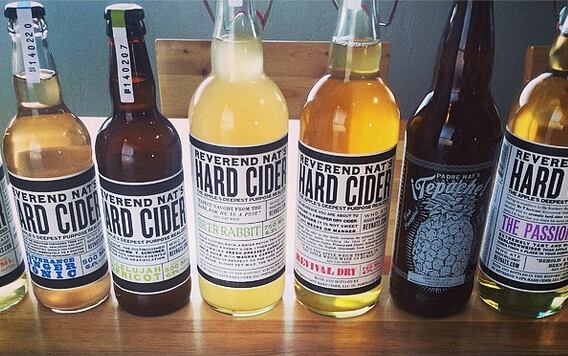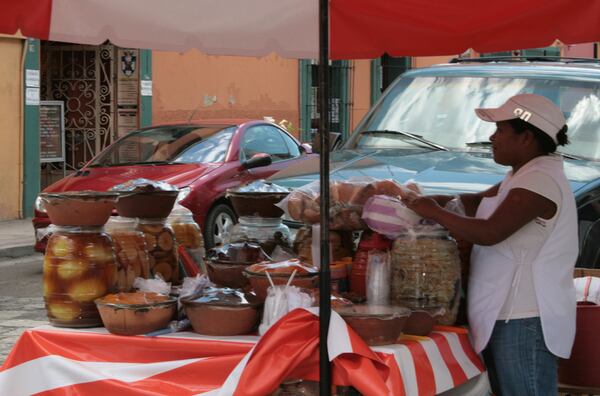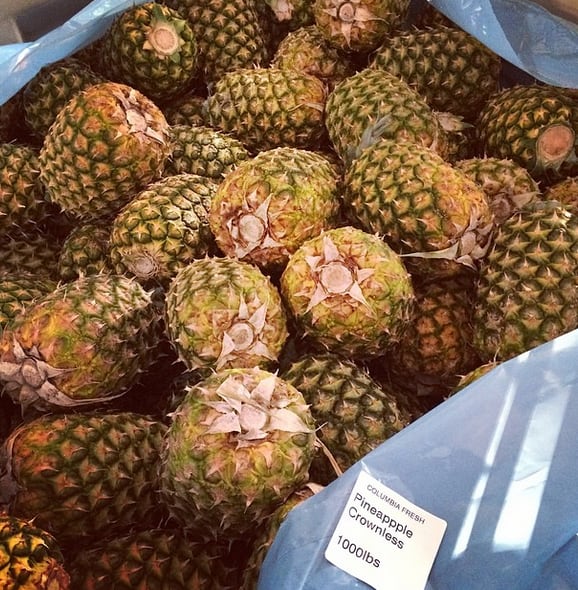Cider pioneer Nat West, who heads up the company, says he sees Tepache, which to his knowledge is only sold commercially by his cidery and two other US producers – Argus Cidery in Austin, Texas and Blossomwood Cidery in Colorado – as a niche category.
Tepache has crept across the Mexico-US border into craft cocktail bars, and Reverend Nat’s Hard Cider launched its first bottled Tepache in Portland, Oregan on May 5 (one of the first in the US, it's the black bottle in the photos above and below), to coincide with Cinco de Mayo.
West tells me the product has almost sold out already – he had thought it would take four months.
Reverend Nat’s first sold tepache from draught kegs last summer. “It caused real excitement, because people in Portland had never really tasted anything like this. Second generation Mexicans – a few said to us ‘My grandmother used to make it just like this!’ which was really encouraging to hear," West explains.
'Astounding sales in the Northwest'
“We’re cutting back in Washington and are not delivering to California as we had hoped, as sales have been so astounding in the Northwest. It’s the most successful product we’ve ever launched, but we won’t make any more this year,” he adds.

'Compelling flavors, but I don't see it as a new category' - Nat West
“It has really compelling flavors, but I don’t think we’re creating a new category. But I could be wrong,” he adds. As we will discover below, the two principal problems facing tepache in the States are production costs and, to a lesser extent, an identity crisis.
What is the proper recipe for tepache? Turns out it’s like arguing about the correct recipe for a Toulouse cassoulet, or, the example West gives, the perfect apple pie...
The stuff sold by Mexican street vendors can be made in buckets – just chuck in water, pineapple and sugar – and is low in alcohol at around 2% ABV, according to this great article by Emma Janzen for Punchdrink.com, which was the first to report on the nascent US tepache trend.
Nascent US tepache trend spreads
She quotes Alba Huerta, bar director at Houston’s The Pastry War saying that the rules of tepache are this: that there are very few rules. Once it’s made Mexican street vendors can throw in anything from sugar cane to chilli spice and beer. She uses her bar’s tepache as a highball mixer, Qui, a chic restaurant in Austin uses its house tepache as a beer cocktail mix.
“As a maker it’s clear, Tepache involves fermented pineapples and piloncillo [Mexican brown] sugar. But it’s a bit like your recipe for apple pie – there’s no defined recipe anyone agrees on,” West tells me.
“There are fundamentals for the apple pie. 'Must have crust, must have apples, must have spices.' But what varieties you put in there, how thick the crust is, do you put topping on? It’s similar to making ‘authentic’ tepache.
'Creating a tepache category from scratch? That'd be a pain in the butt!'
West warns that from a consumer standpoint this tepache identity crisis means, “it would be a pain in the butt to have to create a category about something people have no idea what it is”.
“A lot of people call it tepache cider (that’s incorrect, cider is made from apples, and occasionally pears) but we just call it ‘tepache when people ask what it is, then explain how we made it,” he says.

“I’m not sure which category it’s in – we make our cider and we make tepache. The two other people I’ve found who make commercial, alcoholic tepache are both cider makers,” West adds.
There’s no reason why wineries couldn’t enter the fray – tepache, apache, the name has warlike overtones! – West says, but he explains that since grapes are more difficult to master than apples, there is more room for cider makers to explore other fermentables.
“We’ll never have apples entirely figured out, but you reach a point where it’s pretty repeatable, you get consistency, then you wonder what’s next. Pineapples like apples are acidic, structurally they’re similar – how it’s ground up, presses, how it’s put through your juice processing equipment.
“The fermentation happens similarly, and there a similar sugar levels between the two fruits.”
Americanized tepache, with a fresher, sweeter taste
West says Reverend Nat’s Hard Cider’s tepache is Americanized, to a certain extent, with a fresher, sweeter taste provided by including a lot of fresh, unfermented pineapple juice that takes it down to 3% ABV.
“I've tried the Blossomwood Cidery tepache,” he says, which he brackets with Argus Cidery's drink. “Those two cue a little bit more towards the traditional flavors of tepache that we do.

“Both their products are almost 7% alcohol, ours is about 3%. So it’s a lot less alcohol, a lot sweeter, a lot fresher tasting,” West says.
Reverend Nat’s actually debuted tepache back in 2013, but West says that as an active, live product, it went off really quickly in the kegs “which was frustrating – since we had to constantly make small batches to keep it fresh”.
Thus the cidery bottled its tepache this year - the sacrificial pineapples are pictured - and pasteurized the bottles to prevent further fermentation.
But authentic tepache is expensive...
But West says that, for Reverend Nat’s, there isn’t a lot of money in tepache “We don’t make a lot of money on it as we use whole pineapples flown in from Costa Rica, so it’s expensive to make.”
“Maybe that’s one of the reasons why it can’t become a category all on its own,” West adds, since the cost of making tepache authentically with real pineapples is too high, for his cidery at least.
“We ferment whole pineapples. You take the pineapple, grind it up, then let it ferment as a pile of slurry. It ferments on the skins or scales like that. After it’s fermented we press the alcohol juice out of the pulp,” he says.
"You work the opposite way with apples and grapes. First you squeeze the apples to get the juice out, and then ferment the juice separately. There’s some magic that happens when it ferments on the skin that makes tepache really amazing,” West explains.
Big player could risk authenticity with 'crap ingredients'
“That’s why I don’t know if a big player could come in. They’re gonna use pineapple concentrate, pineapple essence, some crap ingredients and call it tepache. it’ll taste nothing like ours,” he says.
“The other option is to make it in Costa Rica, Hawaii, The Philippines – anywhere they grow pineapples year-round. It seems like a better choice to do that. Maybe in five years I’ll open an operation in Costa Rica making nothing but tepache there and shipping it around the world!” West adds.
*Photo above: Tepache sold at a Mexican street stall in 2008 (Y! Musica/Flickr)
